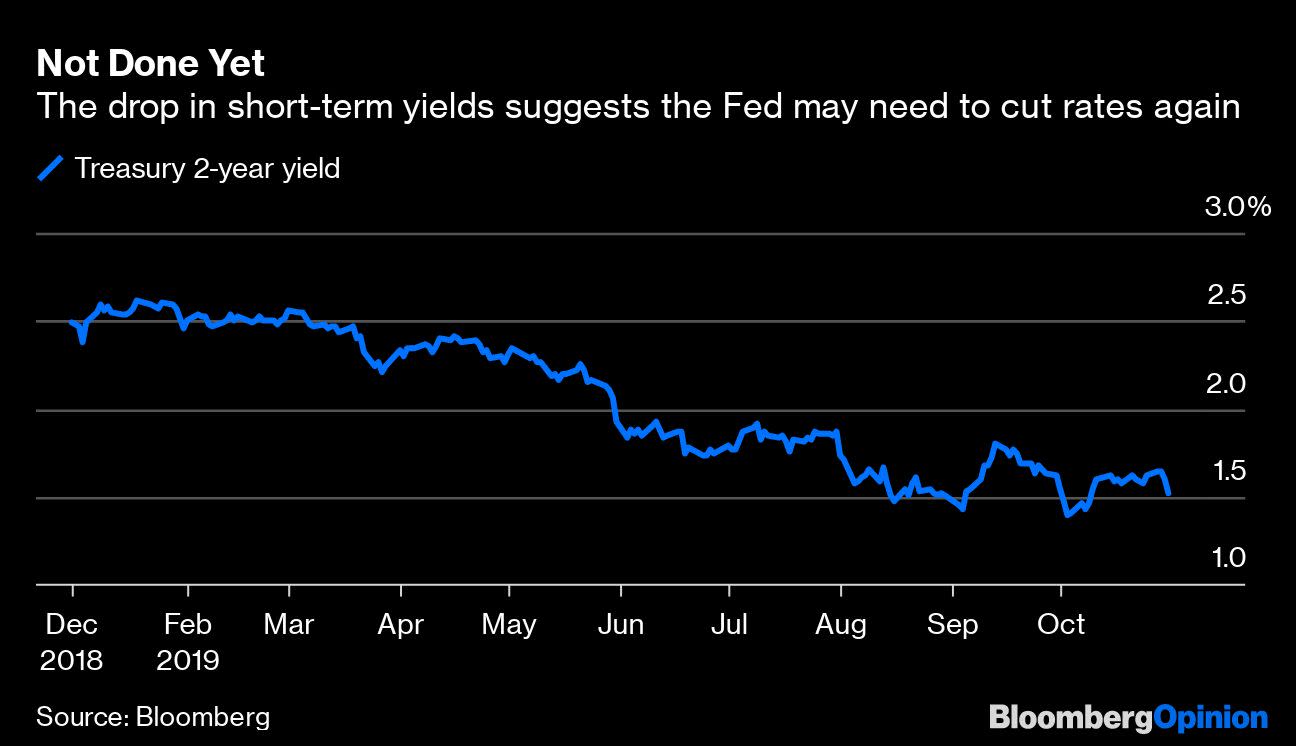
The New York Stock Exchange Composite Index is down 3.68% from its high reached in January 2018, while the Russell 2000 Index is 11.3% below its record set in August 2018.The trigger for the declines Thursday was a Bloomberg News report that Chinese officials are casting doubts about reaching a comprehensive long-term trade deal with the U.S.even as the two sides get close to signing a “phase one” agreement.
That shouldn’t be a total surprise, though, as many traders have speculated that the impeachment hearings against President Donald Trump provide China with little incentive to a broad agreement.What was surprising was the MNI Chicago Business Barometer index, which fell to 43.2 for October from September’s 47.1 when it was forecast to rise to 48.That’s a big miss.Then, the weekly Bloomberg Consumer Comfort Index fell the most in eight years, possibly signaling more moderate household spending approaching the holiday-shopping season.
If that wasn’t enough, the Federal Reserve Bank of Atlanta’s widely-follow GDPNow index that aims to track the economy in real time fell to a paltry 1.46% rate.
It’s hard to criticize Powell.
All else being equal, it’s better for business, consumer and investor confidence to have an optimistic central banker than one who is pessimistic.That said, it’s also good to have a central banker who doesn’t seem out of touch with reality.
We’ll find out soon enough where Powell stands, with a pair of high-level economic data points scheduled to be released Friday in the form of the monthly jobs report and the Institute for Supply Management’s manufacturing index.HOW LONG OF A PAUSE?The bond market sure isn’t acting like the bar to further rate cuts is very high.
After falling 4 basis points on Wednesday, yields on benchmark two-year Treasury notes dropped an additional 7 basis points to 1.53% on Thursday.The probability of another rate reduction happening at the central bank’s next policy meeting in December stands at a not-so-insignificant 30%, which is higher than where it was a month ago, according to data compiled by Bloomberg.Plus, at about 16 basis points, the gap between two- and 10-year yields is lower now than where it was before the Fed started cutting rates at the end of July.If the so-called yield curve really is a reflection of where the economy is headed, then the flattening is a sign that the bond market believes that the Fed’s three rate cuts have done nothing to spark growth.
“We do not think the worst of the downside risks for the Fed have passed yet,” said Wells Fargo Securities strategist Erik Nelson.STOCKS HAVE A NEW LEADERThe U.S.economy has been described as the cleanest of the dirty shirts.In other words, while growth has slowed rapidly in the U.S., it’s still a lot better than most anywhere else in the developed world.
If the recent performance of the global stock market is any indication, that narrative may be about to change.In late trading Thursday, the MSCI All-Country World Index excluding the U.S.was up 3.35% for the month of October, while the MSCI USA Index was up just 2.06%.It’s the greatest outperformance by the non-U.S.
gauge since December.And while the latest monthly sentiment indexes from State Street Global Markets released Wednesday showed investors’ attitudes toward U.S.equities are languishing near all-time lows, those toward European stocks have rebounded and are approaching record highs.In that sense, the global stock market may be signaling that it doesn’t expect U.S.
economic growth to get much worse, but rather growth in the rest of the world may have stopped slowing and will catch up with the U.S.RAW MATERIALS ARE HOPPINGCommodities are another market that may be signaling that the outlook for the global economy isn’t all that bad.The Bloomberg Commodity Index posted its first back-to-back monthly increase in September and October since January and February.The gains have been broad-based, with the energy, agriculture and industrial metals sectors all rising for the month.
The World Bank isn’t too optimistic the gains will continue.The organization on Tuesday cut its price forecast for commodities, saying slower global growth will sap demand for energy, metals and crops.“Expectations for global growth both for 2019 and 2020 have been revised down substantially, including in emerging market and developing economies,” the World Bank said in the report.To be sure, such organizations don’t have the greatest track records in making forecasts, often reacting to the data instead of anticipating trends the way markets do.SHADOW ECONOMY SHRINKSIt didn’t get much attention, but the International Monetary Fund came out with a blog post this week looking at the “global informal” or “shadow” economy.
This is activity that falls outside the regulated economy and tax system, such as street vending or unregistered taxi drivers.The author, IMF senior economist Thomas Alexander, points out that this part of the economy is hard to measure since participants usually operate on a small scale.Nevertheless, Alexander concludes that the informal economy has steadily shrunk as a percentage of gross domestic product in every part of the world since the early 1990s.In the OECD countries, it’s down to about 15% from 20% almost 30 years ago.
The glass-half-full take is that this means the global economy is structurally better, given that the informal economy is generally associated with low productivity, poverty, high unemployment and slower growth.The downside is that it provides opportunities to those who might not otherwise find employment.So, fewer opportunities in this part of the economy may make it harder for many to escape poverty.TEA LEAVESThe Labor Department is expected Friday to say the U.S.economy added 85,000 jobs in October, down from 136,000 in September, according to the median estimate of economists surveyed by Bloomberg.
The reality, though, is that the actual results have just as much chance as exceeding the median estimate as falling below.The top-ranked interest-rate strategists at BMO Capital Markets pointed out in a research note Thursday that five proxies they use to track the health of the labor market are positive, while five are negative.
As they explain, the Fed’s third rate cut since July on Wednesday wasn’t meant “to offset weakness in the labor market but rather to get ahead of any cracks that may appear in coming months.As such, we expect Friday’s payrolls report to confirm that a stable job market continued through October, even if the trade war is beginning to impede hiring across sectors.” But if the labor market continues to slow, it would put pressure on the Fed to cut rates again in December, despite Powell signaling that policy makers are unlikely to do so.DON’T MISS A Bright Spot for the U.S.Economy? This Is It: Robert Burgess Futures Are Pulling Cryptos Out of the Dark: Aaron Brown Powell Will Need a Horror Show to Cut Again: Authers’ Newsletter The Federal Reserve Puts Monetary Policy on Pause: Editorial Lagarde’s Task Is to Lead a Cultural Revolution: Editorial To contact the author of this story: Robert Burgess at [email protected] To contact the editor responsible for this story: Beth Williams at [email protected] This column does not necessarily reflect the opinion of the editorial board or Bloomberg LP and its owners.
Robert Burgess is an editor for Bloomberg Opinion.He is the former global executive editor in charge of financial markets for Bloomberg News.As managing editor, he led the company’s news coverage of credit markets during the global financial crisis.For more articles like this, please visit us at bloomberg.com/opinion ©2019 Bloomberg L.P..
